工程经济学第七章(英文版)
- 格式:pdf
- 大小:4.82 MB
- 文档页数:49
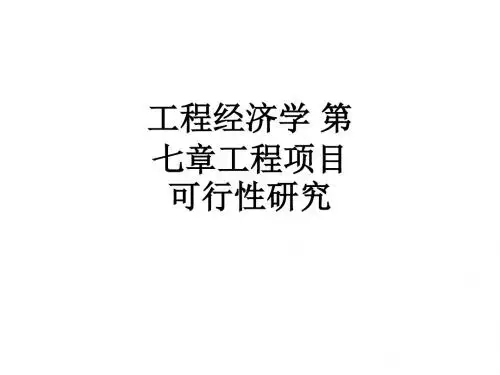
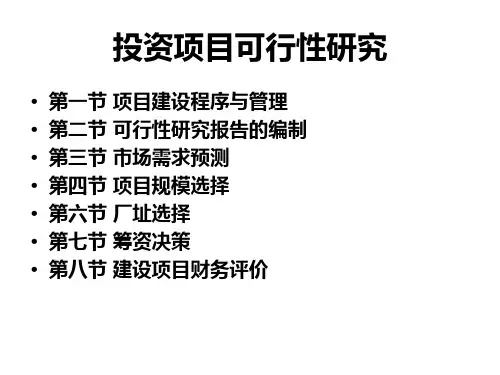
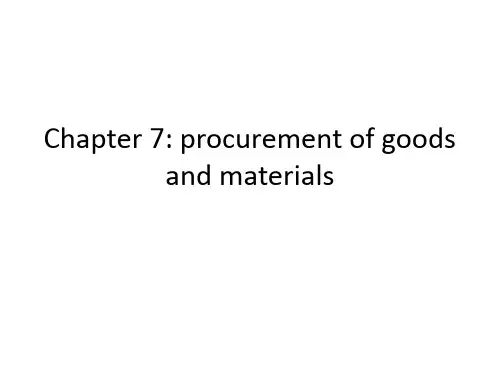
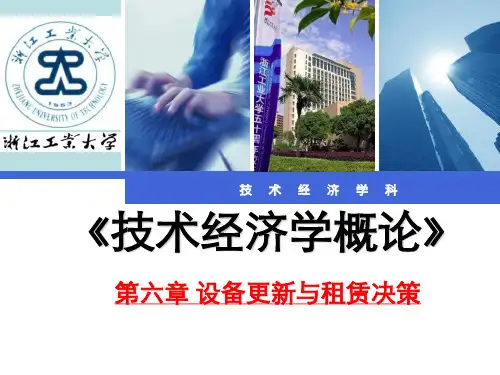
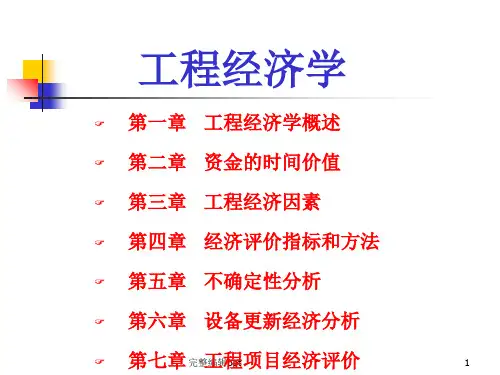
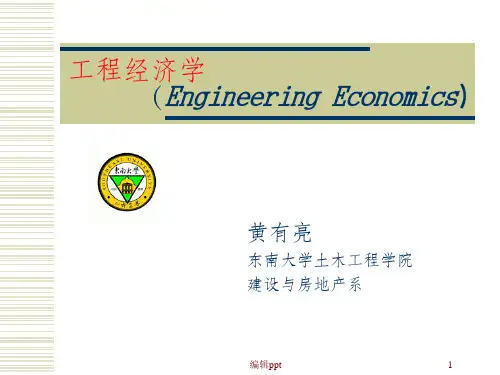
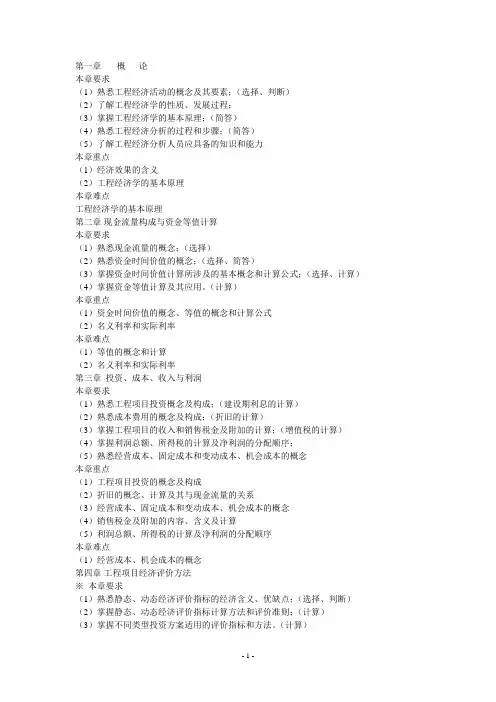
第一章概论本章要求(1)熟悉工程经济活动的概念及其要素;(选择、判断)(2)了解工程经济学的性质、发展过程;(3)掌握工程经济学的基本原理;(简答)(4)熟悉工程经济分析的过程和步骤;(简答)(5)了解工程经济分析人员应具备的知识和能力本章重点(1)经济效果的含义(2)工程经济学的基本原理本章难点工程经济学的基本原理第二章现金流量构成与资金等值计算本章要求(1)熟悉现金流量的概念;(选择)(2)熟悉资金时间价值的概念;(选择、简答)(3)掌握资金时间价值计算所涉及的基本概念和计算公式;(选择、计算)(4)掌握资金等值计算及其应用。
(计算)本章重点(1)资金时间价值的概念、等值的概念和计算公式(2)名义利率和实际利率本章难点(1)等值的概念和计算(2)名义利率和实际利率第三章投资、成本、收入与利润本章要求(1)熟悉工程项目投资概念及构成;(建设期利息的计算)(2)熟悉成本费用的概念及构成;(折旧的计算)(3)掌握工程项目的收入和销售税金及附加的计算;(增值税的计算)(4)掌握利润总额、所得税的计算及净利润的分配顺序;(5)熟悉经营成本、固定成本和变动成本、机会成本的概念本章重点(1)工程项目投资的概念及构成(2)折旧的概念、计算及其与现金流量的关系(3)经营成本、固定成本和变动成本、机会成本的概念(4)销售税金及附加的内容、含义及计算(5)利润总额、所得税的计算及净利润的分配顺序本章难点(1)经营成本、机会成本的概念第四章工程项目经济评价方法※本章要求(1)熟悉静态、动态经济评价指标的经济含义、优缺点;(选择、判断)(2)掌握静态、动态经济评价指标计算方法和评价准则;(计算)(3)掌握不同类型投资方案适用的评价指标和方法。
(计算)※本章重点(1)投资回收期的概念和计算(2)净现值和净年值的概念和计算(3)净现值与收益率的关系(4)内部收益率的含义和计算(5)互斥方案的经济评价方法※本章难点(1)净现值与收益率的关系(2)内部收益率的含义和计算(3)互斥方案的经济评价方法第五章工程项目风险与不确定性分析※本章要求(计算、简答)(1)了解不确定性分析的目的和意义;(2)掌握盈亏平衡分析方法;(线性盈亏平衡、互斥方案的盈亏平衡分析)(3)掌握敏感性分析方法和步骤;(单因素敏感性分析)(4)熟悉风险估计的方法。
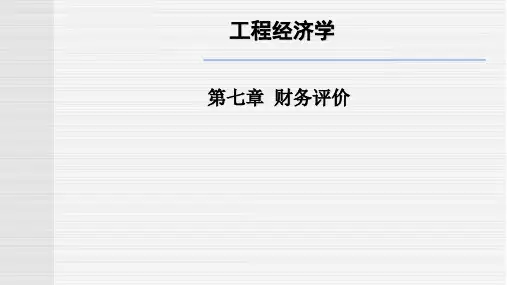
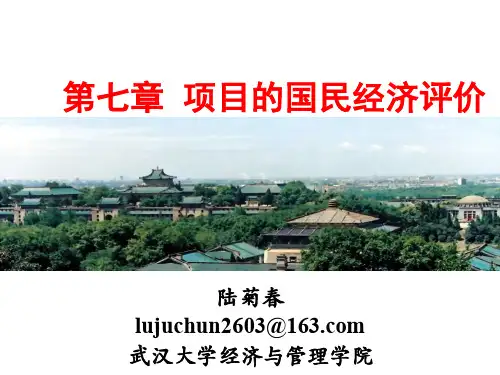
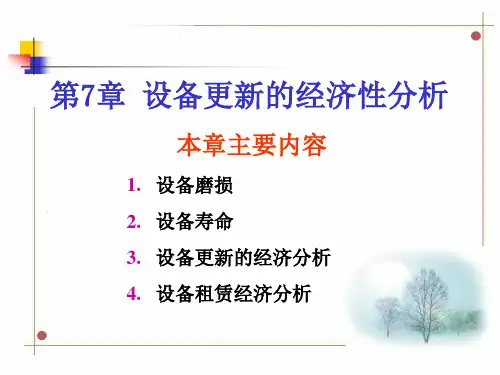
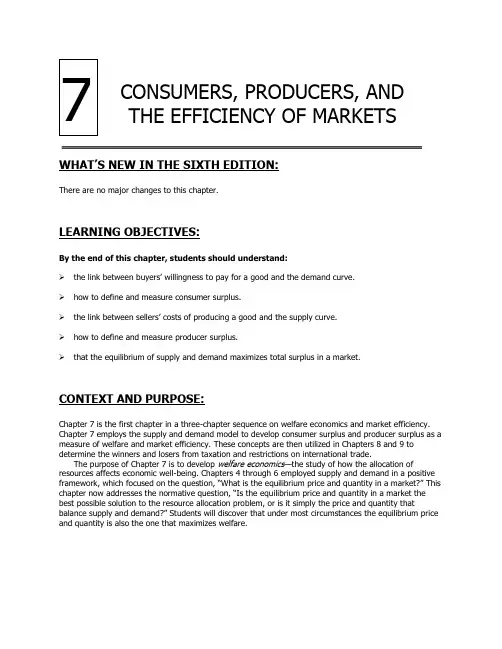
WHAT’S NEW IN THE SIXTH EDITION:There are no major changes to this chapter.LEARNING OBJECTIVES:By the end of this chapter, students should understand:➢ the link between buyers’ willingness to pay for a good and the demand curve.➢ how to define and measure consumer surplus.➢ the link between sellers’ costs of producing a good and the supply curve.➢ how to define and measure producer surplus.➢ that the equilibrium of supply and demand maximizes total surplus in a market.CONTEXT AND PURPOSE:Chapter 7 is the first chapter in a three-chapter sequence on welfare economics and market efficiency. Chapter 7 employs the supply and demand model to develop consumer surplus and producer surplus as a measure of welfare and market efficiency. These concepts are then utilized in Chapters 8 and 9 to determine the winners and losers from taxation and restrictions on international trade.The purpose of Chapter 7 is to develop welfare economics —the study of how the allocation ofresources affects economic well-being. Chapters 4 through 6 employed supply and demand in a positive framework, which focused on the question, “What is the equilibrium price and quantity in a market?” This chapter now addresses the normative question, “Is the equ ilibrium price and quantity in a market the best possible solution to the resource allocation problem, or is it simply the price and quantity thatbalance supply and demand?” Students will discover that under most circumstances the equilibrium price and quantity is also the one that maximizes welfare.7CONSUMERS, PRODUCERS, AND THE EFFICIENCY OF MARKETSKEY POINTS:• Consumer surplus equals buyers’ willingness to pay for a good minus the amount they actually pay for it, and it measures the benefit buyers get from participating in a market. Consumer surplus can be computed by finding the area below the demand curve and above the price.• Producer surplus equals the amount sellers receive for their goods minus their costs of production, and it measures the benefit sellers get from participating in a market. Producer surplus can be computed by finding the area below the price and above the supply curve.•An allocation of resources that maximizes the sum of consumer and producer surplus is said to be efficient. Policymakers are often concerned with the efficiency, as well as the equality, of economic outcomes.• The equilibrium of supply and demand maximizes the sum of consumer and producer surplus. That is,the invisible hand of the marketplace leads buyers and sellers to allocate resources efficiently.• Markets do not allocate resources efficiently in the presence of market failures such as market poweror externalities.CHAPTER OUTLINE:I. Definition of welfare economics: the study of how the allocation of resources affectseconomic well-being.II. Consumer SurplusA. Willingness to Pay1. Definition of willingness to pay: the maximum amount that a buyer will pay for agood.2. Example: You are auctioning a mint-condition recording of Elvis Presley’s first album. Fourbuyers show up. Their willingness to pay is as follows:If the bidding goes to slightly higher than $80, all buyers drop out except forJohn. Because John is willing to pay more than he has to for the album, hederives some benefit from participating in the market.3. Definition of consumer surplus: the amount a buyer is willing to pay for a goodminus the amount the buyer actually pays for it.4. Note that if you had more than one copy of the album, the price in the auction would end upbeing lower (a little over $70 in the case of two albums) and both John and Paul would gain consumer surplus.B. Using the Demand Curve to Measure Consumer Surplus1. We can use the information on willingness to pay to derive a demand curve for the rare ElvisPresley album.PriceBuyersQuantity DemandedMore than $100 None 0 $80 to $100 John1 $70 to $80 John, Paul2 $50 to $70 John, Paul, George3 $50 or lessJohn, Paul, George, Ringo42. At any given quantity, the price given by the demand curve reflects the willingness to pay ofthe marginal buyer . Because the demand curve shows the buyers’ willingness to pay, we can use the demand curve to measure consumer surplus.Figure 1 “This represents the demand curve for the time machine. Consumer surplus is the difference between what consumers are willing to pay and the amount they actually have to pay. The market price will deter mine who uses the time machine and how much surplus they keep.”“If the price of a time machine ride was $500, three rides would be sold—one to Scott, one to Carol, and one to Steve. Jeanne is not willing to pay $500, so she wouldn’t time travel.”“We c an calculate the consumer surplus of three time trips. Scott would pay $3,000 but only pays $500, leaving $2,500 of net benefits.” (Put these numbers on the board.) “Carol has net benefits of $2,000. Steve has $300 in net benefits. Adding up these net savings gives $4,800 in consumer surplus.”Points for DiscussionThe consumer surplus depends on a good’s selling price and the number of consumers who are willing to purchase the good at that price. The lower the price, the greater the consumer surplus.3. Consumer surplus can be measured as the area below the demand curve and above the price. C. How a Lower Price Raises Consumer Surplus1. As price falls, consumer surplus increases for two reasons.a. Those already buying the product will receive additional consumer surplus because theyare paying less for the product than before (area A on the graph).b. Because the price is now lower, some new buyers will enter the market and receiveconsumer surplus on these additional units of output purchased (area B on the graph).D. What Does Consumer Surplus Measure?1. Remember that consumer surplus is the difference between the amount that buyers arewilling to pay for a good and the price that they actually pay.2. Thus, it measures the benefit that consumers receive from the good as the buyersthemselves perceive it.Figure 2Figure 3It is important to stress that consumer surplus is measured in monetary terms. Consumer surplus gives us a way to place a monetary cost on inefficient market outcomes (due to government involvement or market failure).III. Producer SurplusA. Cost and the Willingness to Sell1. Definition of cost: the value of everything a seller must give up to produce a good .2. Example: You want to hire someone to paint your house. You accept bids for the work fromfour sellers. Each painter is willing to work if the price you will pay exceeds her opportunity cost. (Note that this opportunity cost thus represents willingness to sell.) The costs are:3. Bidding will stop when the price gets to be slightly below $600. All sellers will drop out exceptfor Grandma. Because Grandma receives more than she would require to paint the house, she derives some benefit from producing in the market.4. Definition of producer surplus: the amount a seller is paid for a good minus theseller’s cost of providing it.5. Note that if you had more than one house to paint, the price in the auction would end upbeing higher (a little under $800 in the case of two houses) and both Grandma and Georgia would gain producer surplus.ALTERNATIVE CLASSROOM EXAMPLE:Review the material on price ceilings from Chapter 6. Redraw the market for two-bedroom apartments in your town. Draw in a price ceiling below the equilibrium price.Then go through:▪ consumer surplus before the price ceiling is put into place. ▪ consumer surplus after the price ceiling is put into place.B. Using the Supply Curve to Measure Producer Surplus1. We can use the information on cost (willingness to sell) to derive a supply curve for housepainting services.Price Sellers Quantity Supplied$900 or more Mary, Frida, Georgia, Grandma 4$800 to $900 Frida, Georgia, Grandma 3$600 to $800 Georgia, Grandma 2$500 to $600 Grandma 1less than $500 None 02. At any given quantity, the price given by the supply curve represents the cost of the marginalseller. Because the supply curve shows the sellers’ cost (willingness to sell), we can use the supply curve to measure producer surplus.3. Producer surplus can be measured as the area above the supply curve and below the price. Figure 4Figure 5C. How a Higher Price Raises Producer Surplus1. As price rises, producer surplus increases for two reasons.a. Those already selling the product will receive additional producer surplus because theyare receiving more for the product than before (area C on the graph).b. Because the price is now higher, some new sellers will enter the market and receiveproducer surplus on these additional units of output sold (area D on the graph).D. Producer surplus is used to measure the economic well-being of producers, much like consumersurplus is used to measure the economic well-being of consumers.Figure 6ALTERNATIVE CLASSROOM EXAMPLE:Review the material on price floors from Chapter 6. Redraw the market for an agriculturalproduct such as corn. Draw in a price support above the equilibrium price.Then go through:▪ producer surplus before the price support is put in place.▪ producer surplus after the price support is put in place.Make sure that you discuss the cost of the price support to taxpayers.Pretty Woman, Chapter 6. Vivien (Julia Roberts) and Edward (Richard Gere)negotiate a price. Afterward, Vivien reveals she would have accepted a lower price,while Edward admits he would have paid more. If you have done a good job ofintroducing consumer and producer surplus, you will see the light bulbs go off aboveyour students’ heads as they watch this clip.IV. Market EfficiencyA. The Benevolent Social Planner1. The economic well-being of everyone in society can be measured by total surplus, which isthe sum of consumer surplus and producer surplus:Total Surplus = Consumer Surplus + Producer SurplusTotal Surplus = (Value to Buyers – Amount Paid by Buyers) + (Amount Received by Sellers – Cost to Sellers)Because the Amount Paid by Buyers = Amount Received by Sellers:2. Definition ofefficiency: the property of a resource allocation of maximizing thetotal surplus received by all members of society .3. Definition of equality: the property of distributing economic prosperity uniformlythe members of society .B. Evaluating the Market EquilibriumTotal Surplus = Value to Buyers Cost to Sellers Figure 7Now might be a good time to point out that many government policies involve atrade-off between efficiency and equity. When you evaluate government policies, like price ceilings or floors, you can explain them in terms of equity and efficiency.1. At the market equilibrium price:a. Buyers who value the product more than the equilibrium price will purchase the product;those who do not, will not purchase the product. In other words, the free marketallocates the supply of a good to the buyers who value it most highly, as measured bytheir willingness to pay.b. Sellers whose costs are lower than the equilibrium price will produce the product; thosewhose costs are higher, will not produce the product. In other words, the free marketallocates the demand for goods to the sellers who can produce it at the lowest cost.2. Total surplus is maximized at the market equilibrium.Figure 8a. At any quantity of output smaller than the equilibrium quantity, the value of the productto the marginal buyer is greater than the cost to the marginal seller so total surpluswould rise if output increases.b. At any quantity of output greater than the equilibrium quantity, the value of the productto the marginal buyer is less than the cost to the marginal seller so total surplus wouldrise if output decreases.3. Note that this is one of the reasons that economists believe Principle #6: Markets are usuallya good way to organize economic activity.It would be a good idea to remind students that there are circumstances when themarket process does not lead to the most efficient outcome. Examples includesituations such as when a firm (or buyer) has market power over price or when thereare externalities present. These situations will be discussed in later chapters.C. In the News: Ticket Scalping1. Ticket scalping is an example of how markets work to achieve an efficient outcome.2. This article from The Boston Globe descri bes economist Chip Case’s experience with ticketscalping.D. Case Study: Should There Be a Market in Organs?1. As a matter of public policy, people are not allowed to sell their organs.a. In essence, this means that there is a price ceiling on organs of $0.b. This has led to a shortage of organs.2. The creation of a market for organs would lead to a more efficient allocation of resources,but critics worry about the equity of a market system for organs.V. Market Efficiency and Market FailureA. To conclude that markets are efficient, we made several assumptions about how markets worked.1. Perfectly competitive markets.2. No externalities.B. When these assumptions do not hold, the market equilibrium may not be efficient.C. When markets fail, public policy can potentially remedy the situation.SOLUTIONS TO TEXT PROBLEMS:Quick Quizzes1. Figure 1 shows the demand curve for turkey. The price of turkey is P1 and the consumersurplus that results from that price is denoted CS. Consumer surplus is the amount a buyer iswilling to pay for a good minus the amount the buyer actually pays for it. It measures thebenefit to buyers of participating in a market.Figure 1 Figure 22. Figure 2 shows the supply curve for turkey. The price of turkey is P1 and the producersurplus that results from that price is denoted PS. Producer surplus is the amount sellers arepaid for a good minus the sellers’ cost of providing it (measured by the supply curve). Itmeasures the benefit to sellers of participating in a market.Figure 33. Figure 3 shows the supply and demand for turkey. The price of turkey is P1, consumersurplus is CS, and producer surplus is PS. Producing more turkeys than the equilibriumquantity would lower total surplus because the value to the marginal buyer would be lowerthan the cost to the marginal seller on those additional units.Questions for Review1. The price a buyer is willing to pay, consumer surplus, and the demand curve are all closelyrelated. The height of the demand curve represents the willingness to pay of the buyers.Consumer surplus is the area below the demand curve and above the price, which equals theprice that each buyer is willing to pay minus the price actually paid.2. Sellers' costs, producer surplus, and the supply curve are all closely related. The height of thesupply curve represents the costs of the sellers. Producer surplus is the area below the priceand above the supply curve, which equals the price received minus each seller's costs ofproducing the good.Figure 43. Figure 4 shows producer and consumer surplus in a supply-and-demand diagram.4. An allocation of resources is efficient if it maximizes total surplus, the sum of consumersurplus and producer surplus. But efficiency may not be the only goal of economicpolicymakers; they may also be concerned about equity the fairness of the distribution ofwell-being.5. The invisible hand of the marketplace guides the self-interest of buyers and sellers intopromoting general economic well-being. Despite decentralized decision making and self-interested decision makers, free markets often lead to an efficient outcome.6. Two types of market failure are market power and externalities. Market power may causemarket outcomes to be inefficient because firms may cause price and quantity to differ fromthe levels they would be under perfect competition, which keeps total surplus from beingmaximized. Externalities are side effects that are not taken into account by buyers and sellers.As a result, the free market does not maximize total surplus.Problems and Applications1. a. Consumer surplus is equal to willingness to pay minus the price paid. Therefore,Melissa’s willingness to pay must be $200 ($120 + $80).b. Her consumer surplus at a price of $90 would be $200 − $90 = $110.c. If the price of an iPod was $250, Melissa would not have purchased one because theprice is greater than her willingness to pay. Therefore, she would receive no consumersurplus.2. If an early freeze in California sours the lemon crop, the supply curve for lemons shifts to theleft, as shown in Figure 5. The result is a rise in the price of lemons and a decline inconsumer surplus from A + B + C to just A. So consumer surplus declines by the amount B +C.Figure 5 Figure 6In the market for lemonade, the higher cost of lemons reduces the supply of lemonade, asshown in Figure 6. The result is a rise in the price of lemonade and a decline in consumersurplus from D + E + F to just D, a loss of E + F. Note that an event that affects consumersurplus in one market often has effects on consumer surplus in other markets.3. A rise in the demand for French bread leads to an increase in producer surplus in the marketfor French bread, as shown in Figure 7. The shift of the demand curve leads to an increased price, which increases producer surplus from area A to area A + B + C.Figure 7The increased quantity of French bread being sold increases the demand for flour, as shown in Figure 8. As a result, the price of flour rises, increasing producer surplus from area D to D + E + F. Note that an event that affects producer surplus in one market leads to effects on producer surplus in related markets.Figure 84. a. Bert’s demand schedule is:Price Quantity DemandedMore than $7 0$5 to $7 1$3 to $5 2$1 to $3 3$1 or less 4Bert’s demand curve is shown in Figure 9.Figure 9b. When the price of a bottle of water is $4, Bert buys two bottles of water. His consumersurplus is shown as area A in the figure. He values his first bottle of water at $7, butpays only $4 for it, so has consumer surplus of $3. He values his second bottle of water at $5, but pays only $4 for it, so has consumer surplus of $1. Thus Bert’s total consumer surplus is $3 + $1 = $4, which is the area of A in the figure.c. When the price of a bottle of water falls from $4 to $2, Bert buys three bottles of water,an increase of one. His consumer surplus consists of both areas A and B in the figure, an increase in the amount of area B. He gets consumer surplus of $5 from the first bottle($7 value minus $2 price), $3 from the second bottle ($5 value minus $2 price), and $1 from the third bottle ($3 value minus $2 price), for a total consumer surplus of $9. Thus consumer surplus rises by $5 (which is the size of area B) when the price of a bottle ofwater falls from $4 to $2.5. a. Ernie’s supply schedule for water is:Price Quantity SuppliedMore than $7 4$5 to $7 3$3 to $5 2$1 to $3 1Less than $1 0Ernie’s supply curve is shown in Figure 10.Figure 10b. When the price of a bottle of water is $4, Ernie sells two bottles of water. His producersurplus is shown as area A in the figure. He receives $4 for his first bottle of water, but itcosts only $1 to produce, so Ernie has producer surplus of $3. He also receives $4 for his second bottle of water, which costs $3 to produce, so he has producer surplus of $1.Thus Ernie’s total producer surplus is $3 + $1 = $4, which is the area of A in the figure.c. When the price of a bottle of water rises from $4 to $6, Ernie sells three bottles of water,an increase of one. His producer surplus consists of both areas A and B in the figure, anincrease by the amount of area B. He gets producer surplus of $5 from the first bottle($6 price minus $1 cost), $3 from the second bottle ($6 price minus $3 cost), and $1from the third bottle ($6 price minus $5 price), for a total producer surplus of $9. Thusproducer surplus rises by $5 (which is the size of area B) when the price of a bottle ofwater rises from $4 to $6.6. a. From Ernie’s supply schedule and Bert’s demand schedule, the quantity demanded andsupplied are:Price Quantity Supplied Quantity Demanded$2 1 3$4 2 2$6 3 1Only a price of $4 brings supply and demand into equilibrium, with an equilibriumquantity of two.b. At a price of $4, consumer surplus is $4 and producer surplus is $4, as shown inProblems 3 and 4 above. Total surplus is $4 + $4 = $8.c. If Ernie produced one less bottle, his producer surplus would decline to $3, as shown inProblem 4 above. If Bert consumed one less bottle, his consumer surplus would declineto $3, as shown in Problem 3 above. So total surplus would decline to $3 + $3 = $6.d. If Ernie produced one additional bottle of water, his cost would be $5, but the price isonly $4, so his producer surplus would decline by $1. If Bert consumed one additionalbottle of water, his value would be $3, but the price is $4, so his consumer surplus would decline by $1. So total surplus declines by $1 + $1 = $2.7. a. The effect of falling production costs in the market for stereos results in a shift to theright in the supply curve, as shown in Figure 11. As a result, the equilibrium price ofstereos declines and the equilibrium quantity increases.Figure 11b. The decline in the price of stereos increases consumer surplus from area A to A + B + C+ D, an increase in the amount B + C + D. Prior to the shift in supply, producer surpluswas areas B + E (the area above the supply curve and below the price). After the shift in supply, producer surplus is areas E + F + G. So producer surplus changes by the amountF +G – B, which may be positive or negative. The increase in quantity increasesproducer surplus, while the decline in the price reduces producer surplus. Becauseconsumer surplus rises by B + C + D and producer surplus rises by F + G – B, totalsurplus rises by C + D + F + G.c. If the supply of stereos is very elastic, then the shift of the supply curve benefitsconsumers most. To take the most dramatic case, suppose the supply curve werehorizontal, as shown in Figure 12. Then there is no producer surplus at all. Consumerscapture all the benefits of falling production costs, with consumer surplus rising fromarea A to area A + B.Figure 128. Figure 13 shows supply and demand curves for haircuts. Supply equals demand at a quantityof three haircuts and a price between $4 and $5. Firms A, C, and D should cut the hair of Ellen, Jerry, and Phil. Oprah’s willingness to pay is too low and firm B’s costs are too high, so they do not participate. The maximum total surplus is the area between the demand and supply curves, which totals $11 ($8 value minus $2 cost for the first haircut, plus $7 value minus $3 cost for the second, plus $5 value minus $4 cost for the third).Figure 139. a. The effect of falling production costs in the market for computers results in a shift to theright in the supply curve, as shown in Figure 14. As a result, the equilibrium price ofcomputers declines and the equilibrium quantity increases. The decline in the price ofcomputers increases consumer surplus from area A to A + B + C + D, an increase in the amount B + C + D.Figure 14 Figure 15Prior to the shift in supply, producer surplus was areas B + E (the area above the supply curve and below the price). After the shift in supply, producer surplus is areas E + F + G.So producer surplus changes by the amount F + G – B, which may be positive ornegative. The increase in quantity increases producer surplus, while the decline in theprice reduces producer surplus. Because consumer surplus rises by B + C + D andproducer surplus rises by F + G – B, total surplus rises by C + D + F + G.b. Because typewriters are substitutes for computers, the decline in the price of computersmeans that people substitute computers for typewriters, shifting the demand fortypewriters to the left, as shown in Figure 15. The result is a decline in both theequilibrium price and equilibrium quantity of typewriters. Consumer surplus in thetypewriter market changes from area A + B to A + C, a net change of C – B. Producersurplus changes from area C + D + E to area E, a net loss of C + D. Typewriterproducers are sad about technological advances in computers because their producersurplus declines.c. Because software and computers are complements, the decline in the price and increasein the quantity of computers means that the demand for software increases, shifting the demand for software to the right, as shown in Figure 16. The result is an increase in both the price and quantity of software. Consumer surplus in the software market changesfrom B + C to A + B, a net change of A – C. Producer surplus changes from E to C + D + E, an increase of C + D, so software producers should be happy about the technological progress in computers.Figure 16d. Yes, this analysis helps explain why Bill Gates is one the world’s richest people, becausehis company produces a lot of software that is a complement with computers and therehas been tremendous technological advance in computers.10. a. With Provider A, the cost of an extra minute is $0. With Provider B, the cost of an extraminute is $1.b. With Provider A, my friend will purchase 150 minutes [= 150 – (50)(0)]. With Provider B,my friend would purchase 100 minutes [= 150 – (50)(1)].c. With Provider A, he would pay $120. The cost would be $100 with Provider B.Figure 17d. Figure 17 shows the friend’s demand. With Provider A, he buys 150 minu tes and hisconsumer surplus is equal to (1/2)(3)(150) – 120 = 105. With Provider B, his consumersurplus is equal to (1/2)(2)(100) = 100.e. I would recommend Provider A because he receives greater consumer surplus.11. a. Figure 18 illustrates the demand for medical care. If each procedure has a price of $100,quantity demanded will be Q1 procedures.Figure 18b. If consumers pay only $20 per procedure, the quantity demanded will be Q2 procedures.Because the cost to society is $100, the number of procedures performed is too large to maximize total surplus. The quantity that maximizes total surplus is Q1 procedures, which is less than Q2.c. The use of medical care is excessive in the sense that consumers get procedures whosevalue is less than t he cost of producing them. As a result, the economy’s total surplus is reduced.d. To prevent this excessive use, the consumer must bear the marginal cost of theprocedure. But this would require eliminating insurance. Another possibility would be that the insurance company, which pays most of the marginal cost of the procedure ($80, in this case) could decide whether the procedure should be performed. But the insurance company does not get the benefits of the procedure, so its decisions may not reflect the value to the consumer.。
⾦融学原理(英⽂)第七单元课后答案CHAPTER 7ANSWERS7-1 The four financial statements contained in most annual reports are the balance sheet, income statement, statement of retained earnings, andstatement of cash flows.7-2 No, because the $20 million of retained earnings probably would not be held as cash. The retained earnings figure represents the reinvestmentof earnings by the firm. Consequently, the $20 million would be aninvestment in all of the assets of the firm.7-3 Liquidating assets, borrowing more funds, and issuing stock would constitute sources of funds. Purchasing assets, paying off debt, and stockrepurchases would constitute uses of funds. Thus, the following general rules can be used to determine what changes in balance sheet accountsrepresent sources and uses of funds:Sources of cash: Uses of Cash:in a liability or equity account in a liability of equity accountin an asset account in an asset account7-4 The emphasis of the various types of analysts is by no means uniform nor should it be. Management is interested in all types of ratios for two reasons.First, the ratios point out weaknesses that should be strengthened; second,management recognizes that the other parties are interested in all theratios and that financial appearances must be kept up if the firm is tobe regarded highly by creditors and equity investors. Equity investorsare interested primarily in profitability, but they examine the otherratios to get information on the riskiness of equity commitments. Long-term creditors are more interested in the debt ratio, TIE, and fixed chargecoverage ratios, as well as the profitability ratios. Short-term creditorsemphasize liquidity and look most carefully at the liquidity ratios.7-5 The most important aspect of ratio analysis is the judgment used when interpreting the results to reach an overall conclusion concerning a firm'sfinancial position. The analyst should be aware of, and include in theinterpretation, the fact that: (1) large firms with many differentdivisions are difficult to categorize in a single industry; (2) financialstatements are reported at historical costs; (3) seasonal factors candistort the ratios; (4) some firms try to "window dress" their financial statements to look good; (5) firms use different accounting procedures to compute inventory values, depreciation, and so on; (6) there might notexist a single value that can be used for comparing firms' ratios (e.g.,a current ratio of 2.0 might not be good); and (7) conclusions concerningthe overall financial position of a firm should be based on a representativenumber of ratios, not a single ratio.7-6 Differences in the amounts of assets necessary to generate a dollar of sales cause asset turnover ratios to vary among industries. For example,a steel company needs a greater number of dollars in assets to producea dollar in sales than does a grocery store chain such as Safeway. Also,profit margins and turnover ratios might vary due to differences in theamount of expenses incurred to produce sales. For example, one would expecta grocery store chain like Safeway to spend more per dollar of sales thandoes a steel company. Often, a large turnover will be associated with a low profit margin, and vice versa.7-7 ROE can be writtenTotal assets divided by owners' equity, which is termed the equity multiplier, is a measure of debt utilization; the more debt, the higher the equity multiplier. Thus, using more debt will increase the equity multiplier, resulting in a higher ROE.7-8 a. Cash, receivables, and inventories, as well as current liabilities, vary over the year for firms with seasonal sales patterns. Therefore,those ratios that examine balance sheet figures will vary unlessaverages (monthly ones are best) are used.b. Common equity is determined at a point in time, say, December 31, 2002.Profits are earned over time, say, during 2002. If a firm is growing rapidly, year-end equity will be much larger than beginning-of-year equity, so the calculated rate of return on equity will be different depending on whether end-of-year, beginning-of-year, or average common equity is used as the denominator. Average common equity is conceptually the best figure to use.In public utility rate cases, people are reported to have deliberately used end-of-year or beginning-of-year equity to make returns on equity appear exces-sive or inadequate. Similar problems can arise when a firm is being evaluated.7-9 Source(+)2002 2001 or Use(-)?Cash $ 400 $ 500 +Accounts receivable 250 300 +Inventory 450 400 -Current assets 1,100 1,200Net property & equipment 1,000 950 -aTotal assets $2,100 $2,150Accounts payable $ 200 $ 400 -Accruals 300 250 +Notes payable 400 200 +Current liabilities 900 850Long-term debt 800 900 - Total liabilities 1,700 1,750Common stock 250 300 -Retained earnings 150 100 +bTotal liabilities $2,100 $2,150and equitya The book value of property & equipment is stated net of depreciation.Because the book value of fixed assets increased, and depreciation is an adjustment that reduces the account balance, Batelan must have purchased additional fixed assets; but, without more information we cannot determine the amount of the purchase.b The retained earning balance increased in 2002, so Batelan must havegenerated a positive net income. But, without additional information (i.e.the amount of net income), we cannot tell whether dividends were paid in 2002.7-10 Total EffectCurrent Current on NetAssets Ratio Incomea. Cash is acquired through issuanceof additional common stock. + + 0b. Merchandise is sold for cash. + + +(When merchandise is sold, its price is greater than its cost.)c. Federal income tax due forthe previous year is paid. ─ + 0(Both current assets and current liabilities decrease by the samedollar amount. But, because the current ratio is greater than 1.0,it increases as a result of the payment.)d. A fixed asset is sold forless than book value. + + ─e. A fixed asset is sold formore than book value. + + +f. Merchandise is sold on credit. + + +g. Payment is made to tradecreditors for previous purchases. ─ + 0h. A cash dividend is declaredand paid. ── 0i. Cash is obtained through short-term bank loans. + ─ 0j. Short-term notes receivableare sold at a discount. ───k. Marketable securities aresold below cost. ───l. Advances are made to employees. 0 0 0(There is no change in current assets or the current ratio because cash decreases by the same amount prepaid expenses increases.) m. Current operating expensesare paid. ───to trade creditors in exchangefor past due accounts payable. 0 0 0o. Ten-year notes are issued topay off accounts payable. 0 + 0p. A fully depreciated assetis retired. 0 0 0q. Accounts receivable are collected. 0 0 0r. Equipment is purchased withshort-term notes. 0 ─ 0s. Merchandise is purchased on credit. + ─ 0t. The estimated taxes payableare increased. 0 ──SOLUTIONS7-1a.Dollar amounts are in millions.Poor9.9% 7.7% 376$8.28$assets Total income Net averageNear 4.6% 4.1% 700$8.28$Sales income Net Marginal45.0% 48.1% 376$181$assets Total debt Total Average4.1 4.0 175$700$assets Fixed Sales Bad7.2 5.5 101$560$s Inventorie sold goods of Cost Poordays 33.5 days 41.1 )360/700($80$360/Sales receivable Accounts Average3.9 8.3 53$201$s liabilitie Current assets Current Comment Average Argile Industry======??==??====??==b.The ratios do not show any particular strengths. However, Argile does have a low inventory turnover, higher than normal days sales outstanding, and poor return on assets. According to its 2001 ratios, it appears Argile has liquidity problems. c.Ratio 20022001 TrendCurrent ratio 3.6?3.8? Worse Days sales outstanding 43.2 days 41.1 days Worse Inventory turnover4.4?5.5? Worse Fixed assets turnover 3.9? 4.0? Same Debt ratio51.1% 48.1% WorseProfit margin on sales 3.6% 4.1% Worse Return on assets 6.3%7.7%WorseThe above comparison shows that Argile's financial position worsened from 2001 to 2002.d. It would be helpful to know the future plans Argile has with respect to improving its currentfinancial position, introducing new products, liquidating unprofitable investments, and so on. Perhaps the fixed assets turnover ratio and return on assets figures are low because the firm has expanded its product distribution, and this process has a large cost "up front" with significant payoffs beginning in two or three years.7-2 a.60.0%61.90% 500,947$500,586$assets Total debt Total 9.0%7.56% 000,361$300,27$equity Common income Net 3.6%2.88% 500,947$300,27$assets Total income Net 1.2%1.70% 500,607,1$300,27$Sales income Net 3.0 1.70 500,947$500,607,1$assets Total Sales 5.6 5.60 500,241$000,353,1$s Inventorie sold goods of Cost days35.0 days 24.75 28.465,4$000,336$360/Sales receivable Accounts 2.0 98.1 000,330$000,655$s liabilitie Current assets Current Average Campsey Industry ========?========b.For Campsey, ROA = PM ? TA turnover = 1.7% ? 1.7 = 2.89%.For the industry, ROA = 1.2% ? 3.0 = 3.6%.c.Campsey's days sales outstanding is more than twice as long as the industry average, indicating that the firm should tighten credit or enforce a more stringent collection policy. The total assets turnover ratio is well below the industry average so sales should be increased, assets decreased, or both. While Campsey's profit margin is higher than the industry average, its other profitability ratios are low compared to the industry--net income should be higher given the amount of equity and assets. However, the company seems to be in an average liquidity position and financial leverage is similar to others in the industry. d.If 2002 represents a period of supernormal growth for Campsey, ratios based on this year will be distorted and a comparison between them and industry averages will have little meaning. Potential investors who look only at 2002 ratios will be misled, and a return to normal conditions in 2003 could hurt the firm's stock price.7-3(1) Total liabilities and equity = Total assets = $300,000.(2) Debt = (0.50)(Total assets) = (0.50)($300,000) = $150,000. (3) Accounts payable = Debt ─ Long-term debt = $150,000 ─$60,000= $90,000.(4) (5)Sales = (1.5)(Total assets) = (1.5)($300,000) = $450,000.(6)Cost of goods sold = Sales(1 - 0.25) = $450,000(.75) = $337,500(7)Inventory = (CGS)/5 = $337,500/5 = $67,500.(8)Accounts receivable = (Sales/360)(DSO)= ($450,000/360)(36) = $45,000.(9) (Cash + Accounts receivable)/(Accounts payable) = 0.80? Cash + Accounts receivable = (0.80)(Accts payable) Cash + $45,000 = (0.80)($90,000) Cash = $72,000 ─ $45,000= $27,000.(10) Fixed assets = Total assets ─ (Cash + Accts Rec. + Inventories) = $300,000 ─ ($27,000 + $45,000 + $67,500) = $160,500.$52,500= $97,500 $150,000 $300,000 = earnings Retained - Debt - equity and s liabilitie Total = stock Common ??? ????? ?? Balance Sheet Cash$ 27,000 Accounts payable $ 90,000Accounts receivables 45,000 Long-term debt 60,000 Inventories 67,500 Common stock 52,500 Fixed assets 160,500 Retained earnings 97,500 Total assets$300,000$300,0007-4 a.12.9%8.57% 315$27$ equity Total income Net equitytotal on Return 9.0%6.00% 450$27$ assets Total income Net assets total onReturned 3.0%3.40% 795$27$ Sales income Net margin Profit 3.0 1.77 450$795$ assets Total Sales Turnover assets Total 6.0 5.41 147$795$ assets Fixed Sales Turnoverassets Fixed days24.0 days 29.89 360/795$66$ 360/Sales receivable AccountsDSO 8.5 4.15 159$660$ s Inventorie sold goods of Cost turnoverInventory7.0 11.00 5.4$5.49$ Interest EBIT earned interestTimes 30.0%30.00% 450$135$ assets Total Debt assetstotal to Debt 2.0 2.73 111$303$ s liabilitie Current assets Current ratio Current Average Finnerty Industry==============================b. ROA = Profit margin ? Total assets turnover=Net income Sales Sales Total assets = 3.4% 1.77 = 6.0%=$27$795$795$450Finnerty Industry Comment Profit margin 3.4% 3.0% Good Total assets turnover 1.77? 3.0? Poor Return on total assets 6.0%9.0% Poorc. Analysis of the Du Pont equation and the set of ratios shows that the turnover ratio of sales toassets is quite low. Either sales should be increased at the present level of assets, or the current level of assets should be decreased to be more in line with current sales. Thus, the problem appears to be in the balance sheet accounts.d. The comparison of inventory turnover ratios shows that other firms in the industry seem to begetting along with about half as much inventory per unit of sales as Finnerty. If Finnerty's inventory could be reduced this would generate funds that could be used to retire debt, thus reducing interest charges and improving profits, and strengthening the debt position. There might also be some excess investment in fixed assets, perhaps indicative of excess capacity, as shown by a slightly lower than average fixed assets turnover ratio. However, this is not nearly as clear-cut as the over-investment in inventory.e. If Finnerty had a sharp seasonal sales pattern, or if it grew rapidly during the year, many ratiosmight be distorted. Ratios involving cash, receivables, inventories, and current liabilities, as well as those based on sales, profits, and common equity, could be biased. It is possible to correct for such problems by using average rather than end-of-period figures.7-5 a. Here are Cary's base case ratios and other data as compared to the industry:Cary Industry Comment Quick 0.85? 1.0? Weak Current 2.33 2.7? Weak Inventory turnover 4.00? 5.8? PoorDays sales outstanding 37 days 32 days Poor Fixed assets turnover 10.0? 13.0? Poor Total assets turnover 2.34? 2.6? Poor Return on assets 5.9% 9.1% Bad Return on equity 13.07% 18.2% Bad Debt ratio 54.8% 50.0% High Profit margin on sales 2.5% 3.5% Bad EPS $4.71 n.a. -- Stock Price $23.57 n.a. -- P/E ratio 5.0? 6.0? Poor M/B ratio 0.65 n.a. --Cary appears to be badly managed--all of its ratios are worse than the industry averages, and the result is low earnings, a low P/E, a low stock price, and a low M/B ratio. The company needs to do something to improve.b.A decrease in the inventory level would improve the inventory turnover, total assets turnover, and ROA, all of which are too low. It would have some impact on the current ratio, but it is difficult to say precisely how that ratio would be affected. If the lower inventory level allowed Cary to reduce its current liabilities, then the current ratio would improve. The lower cost of goods sold would improve all of the profitability ratios and, if dividends were not increased, would lower the debt ratio through increased retained earnings. All of this should lead to a higher market/book7-6We are given ROA = 3% and Sales/Total assets = 1.5?.From Du Pont equation: ROA = Profit margin ? Total assets turnover 3% = Profit margin (1.5) Profit margin = 3%/1.5 = 2%.We can also calculate Zumwalt's debt ratio in a similar manner, given the facts of the problem. We aregiven ROA, which is NI/A and ROE, which is NI/Equity; if we use the reciprocal of ROE we have the following equation: Debt/Assets = 1 - Equity/A = 1 - 0.60 = 0.40 = 40.0%Thus, Zumwalt's net profit margin = 2% and its debt ratio = 40%.7-7 Present current ratio = $1,312,500/$525,000 = 2.5Minimum current ratio = $1,312,500 + NP$525,000 + NP ?? = 2.0$1,312,500 + ΔNP = $1,050,000 + 2ΔNPΔNP = $262,500.Short-term debt can increase by a maximum of $262,500 without violating a 2-to-1 current ratio, assuming that the entire increase in notes payable is used to increase current assets. Because we assumed that the additional funds would be used to increase inventory, the inventory account will increase to $637,500, and current assets will total $1,575,000.Quick ratio = ($1,575,000 ─ $637,500)/$787,500 = $937,500/$787,500 = 1.19? 7-8 (1)Current liabilities = $270,000. (2)Inventories = $432,000.=?=0.3s liabilitie Current 000,810$0.3sliabilitie Current assetsCurrent ?=-?=4.1$270,000s Inventorie $810,000 4.1sliabilitie Current sInventorie -assets Current(3) Current assets = Cash & Marketable securities+ Accounts receivable + Inventories$810,000 = $120,000 + Accounts receivable + $432,000Accounts receivable = $258,000.(4) ?=?=0.5$432,000CGS0.5Inventory sold goods of CostCGS = $2,160,000.(5) CGS = 0.86 (Sales) 628,511,2$86.0000,160,2$Sales ==(6)7-9TIE = EBIT/INT, so find EBIT and INT. Interest = $500,000 ? 0.1 = $50,000.Net income = $2,000,000 ? 0.05 = $100,000.Taxable income (EBT) = $100,000/(1 - T) = $100,000/0.8 = $125,000. EBIT = $125,000 + $50,000 = $175,000. TIE = $175,000/$50,000 = 3.5?.7-10ROE = NI/EquityNow we need to determine the inputs for the equation from the data that were given. On the left we set up an income statement, and we put numbers in it on the right:Sales (given) $10,000- Cost na EBIT (given) $ 1,000 - INT (given) (300) EBT $ 700 - Taxes (30%) (210) NI $ 490Now we can use some ratios to get some more data:Total assets turnover = 2 = S/TA; TA = S/2 = $10,000/2 = $5,000.D/TA = 60%; so E/TA = 40%; therefore, equity = TA ? E/TA= $5,000 ? 0.40 = $2,000days37 360/628,511,2$$258,000 360/Sales receivableAccounts DSO ===ROE = NI/E = $490/$2,000 = 24.5%, and ROA = NI/TA = $490/$5,000 = 9.8%.7-11 a. Currently, ROE is ROE1 = $15,000/$200,000 = 7.5%.The current ratio will be set such that 2.5 = CA/CL. CL is $50,000, and it will not change, so we can solve to find the new level of current assets: CA = 2.5(CL) = 2.5($50,000) = $125,000. Thisis the level of current assets that will produce a current ratio of 2.5?.At present, current assets amount to $210,000, so they can be reduced by $210,000 ─ $125,000 = $85,000.If the $85,000 generated is used to retire common equity, then the new common equity balance will be $200,000 ─ $85,000 = $115,000.Assuming that net income is unchanged, the new ROE will be ROE2 = $15,000/$115,000 =13.04%. Therefore, ROE will increase by 13.04% ─ 7.50% = 5.54%.b. (1) Doubling the dollar amounts would not affect the answer; the ROE increase would still be5.54%.(2) Current assets would increase by $25,000, which would mean a new ROE of$15,000/$140,000 = 10.71%, which would mean a difference of 10.71% ─7.50% =3.21%.(3)If the company had 10,000 shares outstanding, then its EPS would be $15,000/10,000 = $1.50. The stock has a book value of $200,000/10,000 = $20, so the shares retiredwould be $85,000/$20 = 4,250, leaving 10,000 ─ 4,250 = 5,750 shares. The new EPSwould be $15,000/5,750 = $2.6087, so the increase in EPS would be $2.6087 ─ $1.50 =$1.1087, which is a 73.91% increase, the same as the increase in ROE.(4)If the stock was selling for twice book value, or 2 ? $20 = $40, then only half as manyshares could be retired ($85,000/$40 = 2,125), so the remaining shares would be 10,000─ 2,125 = 7,875, and the new EPS would be $15,000/7,875 = $1.9048, for an increase of$1.9048 ─ $1.5000 = $0.4048.c. We could have started with lower inventories and higher accounts receivable, then had you calculate the DSO, then move to a lower DSO that would require a reduction in receivables, andthen determine the effects on ROE and EPS under different conditions. Similarly, we couldhave focused on fixed assets and the FA turnover ratio. In any of these cases, we could have hadyou use the funds generated to retire debt, which would have lowered interest charges and consequently increased net income and EPS.If we had to increase assets, then we would have had to finance this increase by adding eitherdebt or equity, which would have lowered ROE and EPS, other things held constant.Finally, note that we could have asked some conceptual questions about the problem, either as apart of the problem or without any reference to the problem. For example, "If funds are generatedby reducing assets, and if those funds are used to retire common stock, will the effect on EPSand/or ROE be affected by whether or not the stock sells above, at, or below book value?"7-12 a. Sources and Uses of Funds Analysis:Lloyd Lumber CompanyBalance Sheets (millions of dollars)Jan. 1 Dec. 31 Source UseCash $ 7 $ 15 $ 8Marketable securities 0 11 11Net receivables 30 22 $ 8Inventories 53 75 22Gross fixed assets $ 75 $125 50 Less: depreciation ( 25) ( 35) 10Net fixed assets $ 50 $ 90Total assets $140 $213Accounts payable $ 18 $ 15 3 Notes payable 3 15 12Other current liabilities 15 7 8 Long-term debt 8 24 16 Common stock 29 57 28 Retained earnings 67 95 28 Total liabilitiesand equity $140 $213 $102 $102b. Lloyd Lumber CompanyStatement of Cash Flows, 2002(millions of dollars)Operating Activities:Net income $ 33Other additions (sources of cash):Depreciation $ 10Decrease in accounts receivable 8Subtractions (uses of cash):Increase in inventories ($22)Decrease in accounts payable (3)Decrease in other current liabilities (8)Net cash flow from operations $ 18Long-term Investing Activities:Acquisition of fixed assets ($ 50)Financing Activities:Increase in notes payable $ 12Sale of long-term debt 16Sale of common stock 28Payment of dividends ( 5)Net cash flow from financing $ 51Net increase in cash and marketablesecurities $ 19Cash and marketable securities atbeginning of year 7Cash and marketable securities atend of year $ 26c. Investments were made in plant and inventories. Funds were also utilized to reduce accounts payable and other current liabilities and to increase the cash and marketable securities accounts. Most funds were obtained by increasing long-term debt, selling common stock, and retaining earnings. The remainder was obtained from increasing notes payable and reducing receivables. A quick check of the ratios shows that the company's credit has not deteriorated--the current and quick ratios have increased, and the debt ratio has gone down slightly. Ratio analysis and the sources and uses statement both indicate a healthy situation.7-13 a. Dollars are in millions.Income CashStatement FlowsSales revenues $12.0 $12.0Costs, except depreciation* (9.0) (9.0)Depreciation (1.5) ---Total operating costs (10.5) ( 9.0) (Cash costs)Earnings before taxes $ 1.5 $ 3.0 (Pre-tax CF)Taxes (40%) ( 0.6) ( 0.6) (Cash taxes)Net income (NI) $ 0.9Add back depreciation 1.5Net cash flow = NI + DEP $ 2.4 $ 2.4* Costs, except depreciation = 0.75 $12.0 = $9.0b. Depreciation doubles.Income CashStatement FlowsSales revenues $12.0 $12.0Costs, except depreciation (9.0) (9.0)Depreciation (3.0) ---Total operating costs (12.0) ( 9.0) (Cash costs)Earnings before taxes $ 0.0 $ 3.0 (Pre-tax CF)Taxes (40%) ( 0.0) ( 0.0) (Cash taxes)Net income (NI) $ 0.0Add back depreciation 3.0Net cash flow = NI + DEP $ 3.0 $ 3.0c. Depreciation halves.Income CashStatement FlowsSales revenues $12.00 $12.00Costs, except depreciation (9.00) (9.00)Depreciation (0.75) ---Total operating costs ( 9.75) ( 9.00) (Cash costs)Earnings before taxes $ 2.25 $ 3.00 (Pre-tax CF)Taxes (40%) ( 0.90) ( 0.90) (Cash taxes)Net income (NI) $ 1.35Add back depreciation 0.75Net cash flow = NI + DEP $ 2.10 $ 2.10d. The after-tax cash flows are greater if Congress increases the allowance for depreciation, so you should prefer greater depreciation.7-14 The solution is given in the Instructor's Manual, Solutions to Integrative Problems. 7-17 Computer-Related Problema. The revised data and ratios are shown below:INPUT DATA: KEY OUTPUT:2000 Cary IndustryCash $ 84,527 Quick 1.2 1.0A/R 395,000 Current 3.0 2.7Inventories 700,000 Inv. turn. 6.1 5.8Land and bldg 238,000 DSO 33 32Machinery 132,000 F.A.turn. 8.3 13.0Other F.A. 150,000 T.A.turn. 2.5 2.6ROA 10.5% 9.1% Accts & Notes Pay. $ 275,000 ROE 19.9% 18.2%Accruals 120,000 TD/TA 47.0% 50.0%Long-term debt 404,290 PM 4.2% 3.5%Common stock 575,000 EPS $7.78 n.a.Retained earnings 325,237 Stock Price $46.68 n.a.__________P/E ratio 6.0 6.0Total assets $1,699,527 M/B 1.19 n.a.Total claims $1,699,527Income statementSales $4,290,000Cost of G.S. 3,450,000Adm. & sales exp. 248,775Depreciation 159,000Misc. 134,000Net income $ 178,935P/E ratio 6No. of shares 23,000Cash dividend $ 0.95Under these new conditions, Cary Corporation looks much better. Its turnover ratiosare still low, but its ROA and ROE are above the industry average, its estimated P/Eratio is better, and its stock price is anticipated to double. There is still room forimprovement, but the company is in much better shape.b. The financial statements and ratios for the scenario in which the cost of goods solddecreases by an additional $125,000 are shown on the next page. As you can see, the profit ratios are quite high and the stock price has risen to $66.24.INPUT DATA: KEY OUTPUT:2000 Cary IndustryCash $ 159,527 Quick 1.4 1.0A/R 395,000 Current 3.2 2.7Inventories 700,000 Inv. turn. 4.8 5.8Land and bldg 238,000 DSO 33 32Machinery 132,000 F.A.turn. 8.3 13.0Other F.A. 150,000 T.A.turn. 2.4 2.6ROA 14.3% 9.1% Accts & Notes Pay. $ 275,000 ROE 26.0% 18.2%Accruals 120,000 TD/TA 45.0% 50.0%Long-term debt 404,290 PM 5.9% 3.5%Common stock 575,000 EPS $11.04 n.a.Retained earnings 400,237 Stock Price $66.24 n.a.__________P/E ratio 6.0 6.0Total assets $1,774,527 M/B 1.56 n.a.Total claims $1,774,527Income statementSales $4,290,000Cost of G.S. 3,325,000Adm. & sales exp. 248,775Depreciation 159,000Misc. 134,000__________Net income $ 253,935P/E ratio 6No. of shares 23,000Cash dividend $ 0.95c. The financial statements and ratios for the scenario in which the cost of goods soldincreases by $125,000 over the revised estimate are shown on the next page. As you can see, profits would decline sharply. The ROE would drop to 12.6%, EPS wouldfall to $4.52, the stock price would drop to $27.11, and the M/B ratio would be only0.76.INPUT DATA: KEY OUTPUT:2000 Cary IndustryCash $ 9,527 Quick 1.0 1.0A/R 395,000 Current 2.8 2.7Inventories 700,000 Inv. turn. 5.1 5.8Land and bldg 238,000 DSO 33 32Machinery 132,000 F.A.turn. 8.3 13.0Other F.A. 150,000 T.A.turn. 2.6 2.6ROA 6.4% 9.1%Accts & Notes Pay. $ 275,000 ROE 12.6% 18.2%Accruals 120,000 TD/TA 49.2% 50.0%Long-term debt 404,290 PM 2.4% 3.5%Common stock 575,000 EPS $4.52 n.a.Retained earnings 250,237 Stock Price $27.11 n.a.__________P/E ratio 6.0 6.0Total assets $1,624,527 M/B 0.76 n.a.Total claims $1,624,527Income statementSales $4,290,000Cost of G.S. 3,575,000Adm. & sales exp. 248,775Depreciation 159,000Misc. 134,000__________Net income $ 103,935P/E ratio 6No. of shares 23,000Cash dividend $ 0.95d. Computer models allow us to analyze quickly the impact of operating and financialdecisions on the firm's overall performance. A firm can analyze its financial ratios under different scenarios to see what might happen if a decision, such as the purchase of a new asset, did not produce the expected results. This gives the managers some idea about what might happen under the best and worst cases and helps them to make better decisions.。